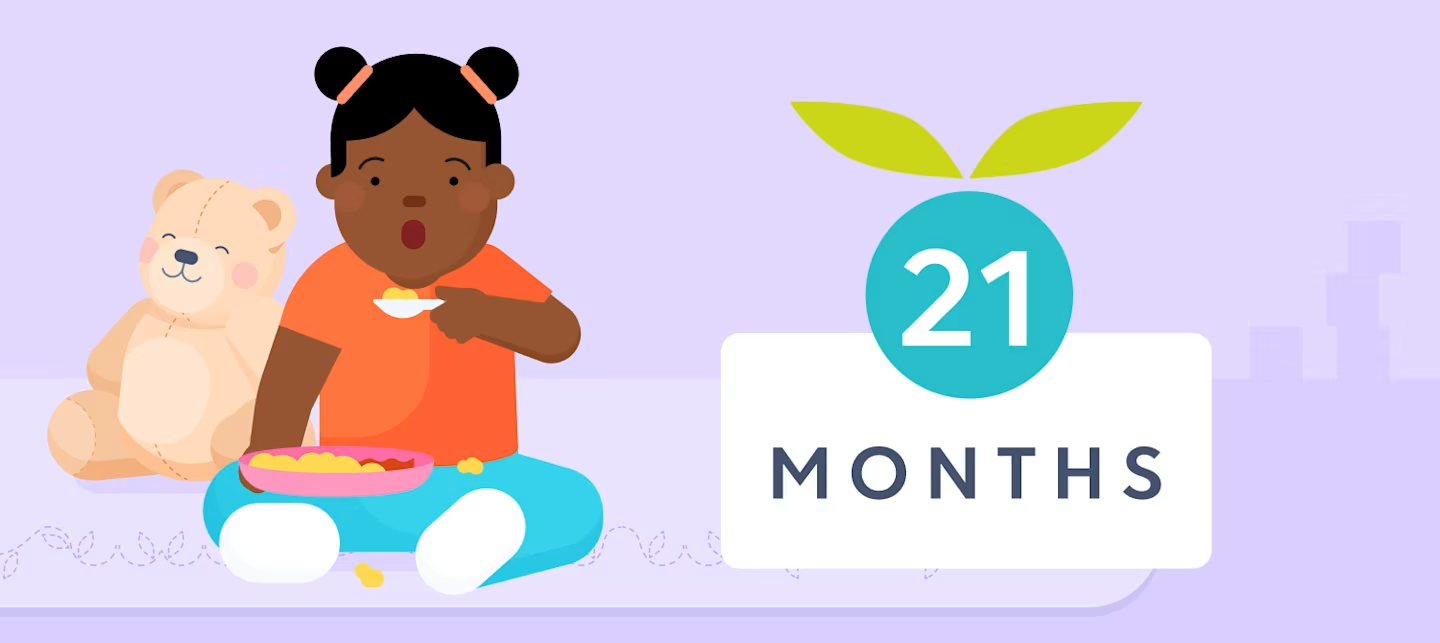21 month old toddler milestones: Development, growth, speech, language
Updated Dec 02, 2025

When your toddler reaches 21 months old, it may feel like your precious baby is morphing into a moody teenager. But these mood swings and temper tantrums are all part of normal 21 month old development! Expected milestones at this age also typically include a mix of increased independence and separation anxiety at the same time, a rapid understanding of new words, and mastering new physical skills. In this article, we’ll take you through the range of milestones that toddlers often reach between 21 - 22 months, including speech, language, and emotional development and new motor skills. We’ll also give you a handy 21 month old development checklist, and provide useful tips to support your little one’s growth.
Editor's note
When we discuss children and development at Huckleberry, we use their adjusted age (vs. actual age). Not all kids will reach 21 month old milestones at the same time — and that’s normal. There’s a wide spectrum when it comes to how fast toddlers grow and develop. While many kids do reach these milestones between 21 - 22 months, this isn’t always the case. If you have any concerns or questions about your child’s development, reach out to their pediatrician.
Table of Contents
21 month old toddler milestones at a glance
At one year and nine months, your little one is likely learning new skills as they continue to work on some old ones.
Development:
As their second birthday nears, toddlers may say as many as 50 - 100 words []. Some 21 month olds may also start using that expanded vocabulary to better express what they want and put two words together to form their first simple sentences (e.g. “go up” when they want to be picked up). At this age, toddlers are also often inquisitive and put new fine motor skills to work, using their hands to explore objects and do new things.
Sleep:
At 21 months, we recommend aiming for at least per day (including one afternoon nap) to be sufficiently rested. This may look like at least 11 hours of nighttime sleep and 1.5 - 2.5 hours of daytime sleep. Your little one may be able to comfortably stay up longer between sleeps now and may need 5.5 - 5.75 hours of awake time before bedtime to help prevent overtiredness and set your little one up for a good night’s sleep. Most children continue to need a nap until at least 3 years old, so continue to offer a daily nap even if your child resists sometimes.
Keep in mind that every child is different, and so are their sleep needs. These sleep totals are general recommendations — and what’s normal and healthy may differ for your child. It’s also important to monitor your toddler's mood and energy levels to help determine if they’re getting enough sleep.
It’s not uncommon for toddlers to experience disrupted sleep around this age due to a variety of factors like , changing sleep needs, and separation anxiety. Toddlers also often gain another set of molars around 21 months, and this teething pain can lead to sleep challenges as little ones need some extra comfort (especially at night).
If you’d like personalized sleep guidance for your toddler, especially as you navigate schedule changes and possible nap or bedtime resistance, consider submitting for a sleep plan through. Our step-by-step plans are tailored to your child’s needs as well as your family’s goals.
Feeding:
While it may feel like your toddler only wants to eat snacks, it’s normal for 21 month olds to eat roughly five times a day. This often looks like per day. It’s also developmentally appropriate for your little one to suddenly refuse foods (even favorite foods!). Picky eating is common from about 2 - 4 years old []. It can be very frustrating for caregivers, but isn’t a reflection of your parenting skills.
To help your child through a phase of picky eating, consider trying things like offering new foods multiple times (it can take around 15 exposures for toddlers to accept a new food []), ensuring your child comes to the table hungry, and avoiding distractions (like TV) at the table. If you’re concerned about how much your child is eating or they’re a severe picky eater, reach out to their healthcare provider for specific guidance.
21 month developmental milestones
Physical development at 21 months
Gross motor milestones
Toddlers typically learn to run, stand on their tiptoes, and kick a large ball between 19 - 24 months []. You can also expect little ones in this age range to start squatting during play, throwing a ball forward, and trying to catch a ball (with their arms or body) []. At 21 months, little ones may also be able to pull toys behind them while walking and start jumping with both feet off the ground. Around this age, some toddlers may also try to walk (not climb) up stairs without support [], use their feet to move on a riding toy, and begin to look coordinated while running []. You can expect most kiddos to master these skills by their second birthday [].
However, don’t worry if your little one isn’t an Olympic jumper or coordinated sprinter by 21 months — there’s a wide range of normal when it comes to milestones. However, check in with your child’s healthcare provider if they’re not taking independent steps yet [].
Fine motor milestones
Many 21 month olds are actively learning to use their hands and fingers to do new things, including figuring out how to work toy buttons, doors, and gears []. Kiddos this age typically can also scribble, turn the pages of a book, stack 5 - 6 blocks [], pull apart connecting toys and put them back together again, and start feeding themselves using a [] or fork []. As kiddos near their second birthday and their coordination improves, you can also expect to see them learning to put large square pegs into matching holes [], fold paper (if you show them how), and make shapes with clay.
Speech development
Language skills: By 21 months, toddlers typically use at least 50 words [], name objects and pictures, consistently imitate new words, and understand simple pronouns (e.g. me, you, my). Some toddlers this age may also begin using two-word phrases, understand action words, use gestures in pretend play, and follow 2-step directions. As your toddler approaches 21 - 22 months, they’re likely constantly adding to their vocabulary, even if it doesn’t seem like it just yet. That’s because toddlers typically go through a period of “language explosion” [] between 18 - 24 months, where they rapidly absorb new words faster than they can say them. During this time, little ones can understand more words than they speak (and some also mimic what they overhear) [], so you may want to watch what you say around them!
Pointing and recognizing: Your 21 month old may be putting their pointer finger to use this month, understanding they can use it to communicate as their language comprehension blooms. For some, this may look like a demanding little finger eagerly pointing to things of interest []. Or, recognizing the names of familiar people, food, or objects [] and pointing to them. Toddlers this age may also be able to point to 3 - 5 body parts [] and specific objects in a picture when named for them [].
Social development
Recognizing feelings: As toddlers near their second birthday, they may become aware of others’ feelings — even if they don’t quite understand them. Kiddos this age may begin to notice when someone is hurt or upset (and pause or look sad in response) or turn to you to see how you react as they work on developing empathy [].
Unpredictable moods:It may feel like you’re in the throes of the “Terrible Twos” long before your little one even turns 2! These unpredictable mood swings are common at this age because toddlers are learning new skills that allow for greater independence while, at the same time, also starting to understand that they’re a separate individual from you (which can be scary) []. At some moments, they may be thrilled to exert that independence and test new skills for themselves, at other times, they may turn back into a clingy kiddo, needing their loved one for comfort. They’re also still figuring out how to effectively communicate what they want — and coping with frustration when they can’t have it.
Getting physical: 21 month olds tend to view themselves as the center of the world []. Although they can play alongside other kids at this age, they still have that limited awareness of others’ feelings (they’re working on it, though!). This often leads to toddlers getting physical with other kiddos, whether they’re responding positively, negatively, or just exploring []. They also don’t understand the idea of sharing quite yet []. At the same time, they’re gaining self-awareness and, with it, the concept of “mine!” [] This often contributes to playdates getting physical as toddlers compete for toys and assert ownership of their items. This period of possessiveness and physicality is usually just a phase and can actually be good. It often signifies an important milestone in your child's thinking and emotional development: understanding self-awareness (which is the foundation for important emotions including empathy, self-confidence, and pride!).
21 month milestone checklist
Below is a general checklist of milestones toddlers may reach by 21 months. Keep in mind all toddlers are unique, and there's a spectrum of normal milestones at this age. However, if you are concerned about your child’s growth or developmental delays, contact their healthcare provider.
Milestones to watch for at 21 months:
Uses simple phrases (18 - 24 months) []
Starts to jump with both feet leaving the ground
Runs
Stands on tiptoes
Climbs on low furniture
Kicks large ball
Goes up and down stairs (with support)
Flips switches on and off
Scribbles
Sorts shapes and colors
Stacks 5+ or more small blocks or toys
Takes toys apart and puts them back together
Uses at least 50 words (19 - 21 months)
Consistently imitates new words (19 - 21 months)
Understands simple pronouns (me, you, my) (19 - 21 months)
Identifies 3 - 5 when named []
Locates objects you’re pointing to
Eats with a spoon (19 - 24 months)
Holds something in one hand while using the other hand (19 - 24 months)
Tries to flip switches, turn knobs, and press buttons (19 - 24 months)
Plays with more than one toy at the same time (19 - 24 months)
What are 21 month development red flags?
Every toddler develops at their own pace. It’s normal for milestones to vary, but there are certain signs that may need a closer look from your child’s healthcare provider. Reach out if your 21 month old []:
Isn’t pointing
Isn’t walking
Doesn’t share or show things to others
Doesn’t seem to understand how to use everyday objects (like a brush or cup)
Doesn’t try to copy the actions of others
Doesn’t say at least six words or isn’t adding new words
Doesn’t respond when a caregiver leaves or returns
Loses skills they once had
If you’re ever unsure or have concerns about your toddler’s development, it’s always best to check in with their doctor.
3 development tips for 21 months
Tip | Why it helps | What to try |
|---|---|---|
Encourage independent play | Solo play builds confidence, creativity, self-regulation, and problem-solving — all major skills at this age. | Create a safe, supervised play space. Let your toddler explore on their own, then invite them to show you what they worked on. |
Keep an eye out during playdates | Toddlers are still learning boundaries and social rules. Active guidance helps them practice sharing and conflict resolution. | Stay close, model turn-taking, and gently step in when things get too physical. Use simple prompts like, “Let’s try taking turns." |
Point and play | Pointing supports language, early literacy, cognitive development, and body-awareness skills. | During books or play, point to pictures and ask your toddler to identify objects, sounds, colors, or body parts. Try simple matching or sorting games to build early skills. |
Find more details below:
Tip #1: Encourage independent play
Solo play gives toddlers opportunities to discover more about themselves, strengthen problem-solving skills, spark creativity, build confidence, explore their strengths, and practice self-regulation. It can also be a nice break for parents! Designate a specific space for them to safely play (where you can see and hear them) and celebrate their bit of independence by asking them to tell you about the things they did. This can help build their sense of pride and comfort with playing on their own next time.
Tip #2: Keep an eye out during playdates
Stick around during playdates and take advantage of teachable moments and the opportunity to model desired behaviors. Toddlers are often very physical with each other, whether showing affection or asserting dominance over a possession, without realizing that they can hurt someone. You can help your little one navigate conflict resolution by showing them how to take turns and redirecting when things get too physical []. It’s common for parents to have to play referee during playdates at this age but they learn important social skills from the behaviors you model [].
Tip #3: Point and play
You can also help your 21 month old reach new milestones by mixing some extra pointing and playing into your days. During storytime, try pointing to parts of the story in the pictures as you’re reading or asking them to point to familiar objects on the page. Consider asking them to point to a specific animal, or if you point to an animal, ask what sound it makes. Or if you point to a body part on a doll or stuffed animal, ask if they can point to their same body part. You can also work on pointing out different colors, shapes, and sizes you see throughout the day and work on sorting toys with them.
Activities for toddlers at 21 months
1. Try dividing responsibilities during meals
As your 21 month old continues exploring new foods and discovering their likes and dislikes, not all mealtimes will go smoothly. Many toddlers go through a selective eating phase around this age, and that’s OK. But instead of becoming a short-order cook or forcing them to eat, try the approach. With this strategy, parents choose what food to serve and kids decide what and how much to eat of the foods offered. Not only does this division of responsibility help keep family meals pressure-free, but it also allows your child to work on developing good habits, feel empowered around eating, and continue creating a healthy relationship with food.
2. Label feelings
As toddlers this age learn about feelings, naming these emotions for them can help little ones better understand what they’re feeling and seeing []. Try labeling your own feelings and the feelings of others (e.g. “I’m happy because we’re playing together” or “She’s sad because she lost”). Also, try putting your child’s feelings into words (e.g. “I understand you’re frustrated because you want to keep reading, and it’s time for bed”). This may help your little one learn how to regain control during an emotional moment and show compassion to others.
Caring for a sick 21 month old
When toddlers are sick, their sleep, energy, and appetite can all be affected. These tips can help your little one feel more comfortable and supported while they recover — and hopefully they’ll be back to their usual self quickly.
Keep them hydrated: Fluids are especially important when your toddler isn’t feeling well. It’s normal if meals are less appealing, so offer frequent small sips of water or milk to keep them hydrated.
Ease congestion: A stuffy nose can make eating and sleeping more difficult. A cool-mist humidifier, saline drops, and gentle suction can help clear nasal passages, particularly before naps and bedtime.
Monitor fevers: Call your pediatrician if your toddler’s fever lasts more than 24 hours or repeatedly rises above 104°F (40°C) []. If your doctor approves, infant or children’s Tylenol or Motrin may be given. Avoid cough and cold medicines, which are not safe for young children.
Be flexible with sleep: Illness can disrupt normal sleep patterns. Your toddler may nap more, nap less, or wake more frequently at night. Follow their cues now and return to your regular schedule once they’re feeling better.
Offer extra comfort: Some toddlers need extra cuddles, while others prefer a bit of space when sick. Pay attention to their cues and respond in ways that make them feel safe and cared for. Caring for a sick toddler can be tiring for parents too — lean on your support network whenever possible.
When to seek help
If your child has a fever for more than 24 hours or it reaches above 104°F (40°C), call their doctor right away. These can be signs of a more serious infection or illness and it's best to rule out anything that needs medical attention.
In general, if something feels off or you’re worried about how your child looks or acts, it’s safest to check in with their doctor. And if you already talked to them but symptoms appear worse, that’s a good time to check back in too.
Takeaway
Toddlers at 21 months are often learning to run, stand on their tiptoes, and kick a large ball. You can also expect little ones in this age range to start squatting during play, throwing a ball forward, and trying to catch a ball (with their arms or body). They may say as many as 50 -100 words [] and be going through a “language explosion” while rapidly comprehending new words — even if they can’t speak them yet.
21 month olds typically have 1 midday nap with as much as 5.75 hours of awake time before bed. At this age, we recommend aiming for 1.5 - 2.5 hours of daytime sleep and at least 12.5 hours of total sleep per day to be sufficiently rested.
As toddlers approach their second birthday, they typically need three meals and two snacks per day. However, it’s normal to see bouts of picky eating and/or an inconsistent appetite at this age.
Keep in mind there’s a wide range of what’s considered “normal” when it comes to 21 month milestones. Not all toddlers are on the same timeline as they approach their second birthday and it's OK if your little one hasn’t mastered all of these skills just yet. However, always listen to your gut and contact your child’s healthcare provider if you notice any concerns, developmental red flags, or delays.
21 month developmental milestones FAQ
Share article:
Note: The content on this site is for informational purposes only and should not replace medical advice from your doctor, pediatrician, or medical professional. If you have questions or concerns, you should contact a medical professional.
14 Sources
Table of Contents
Share article:





